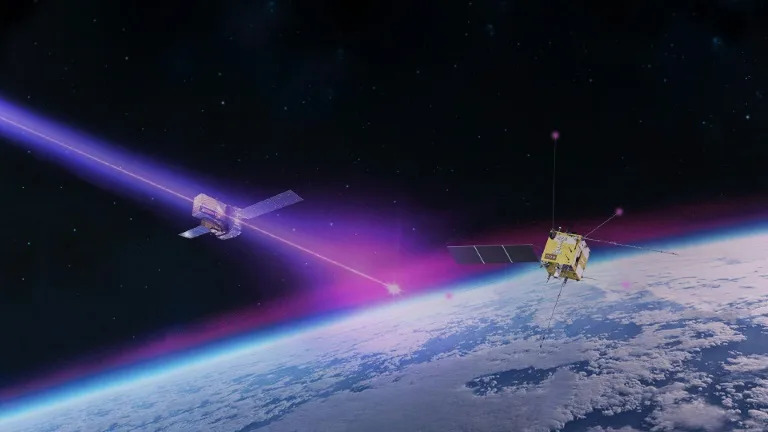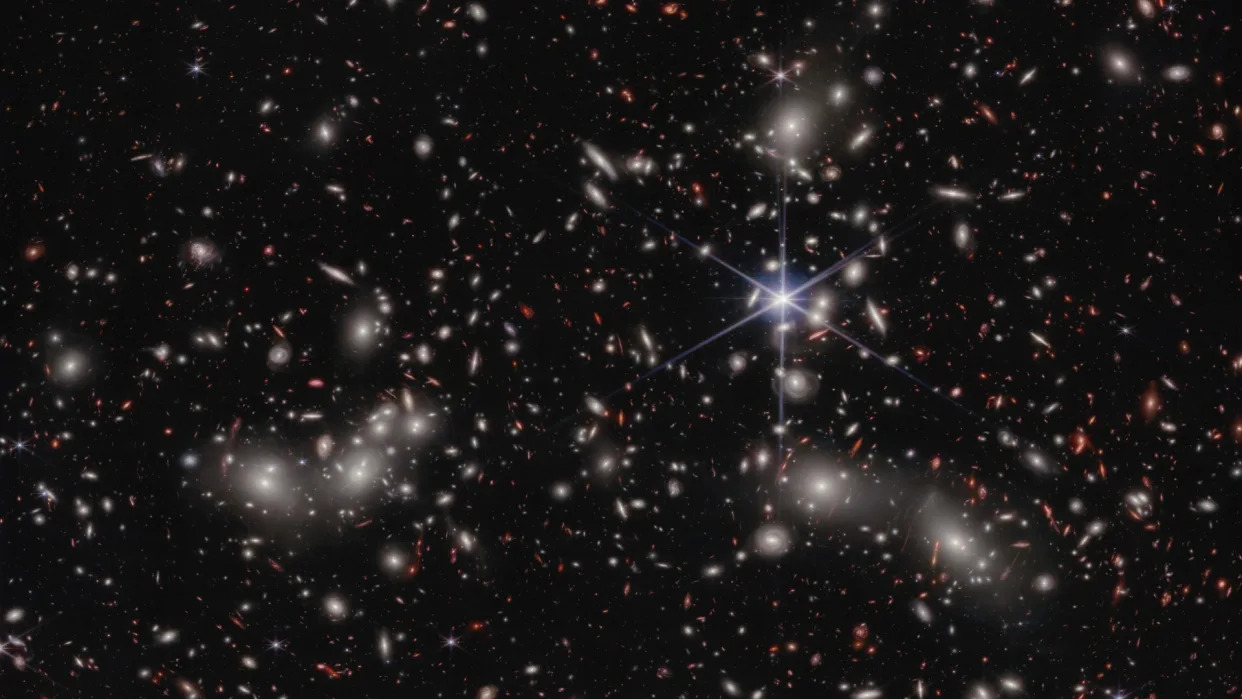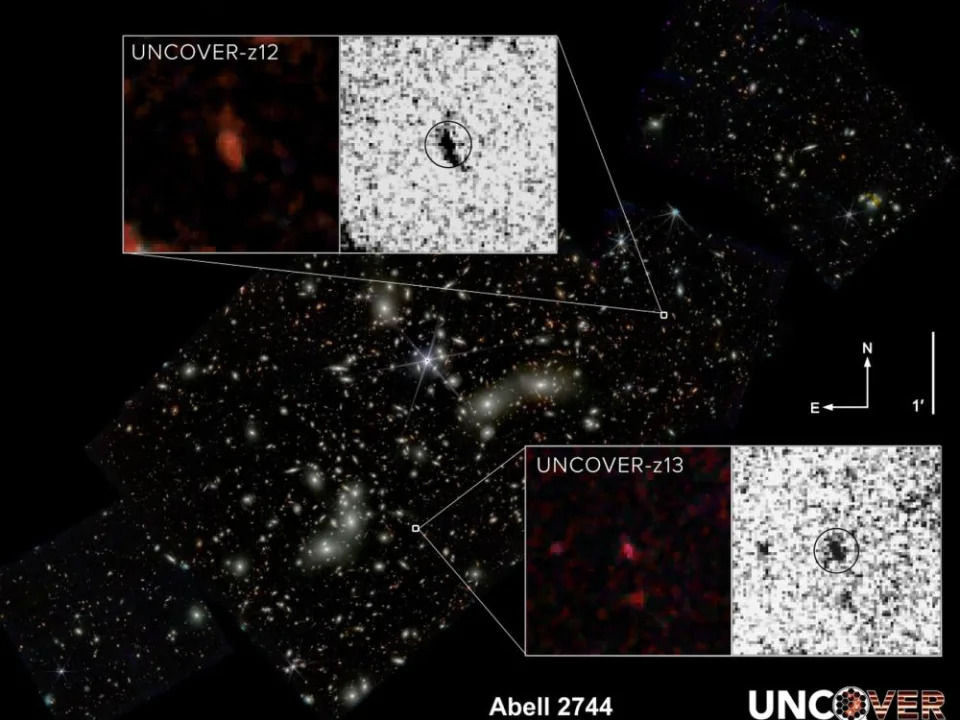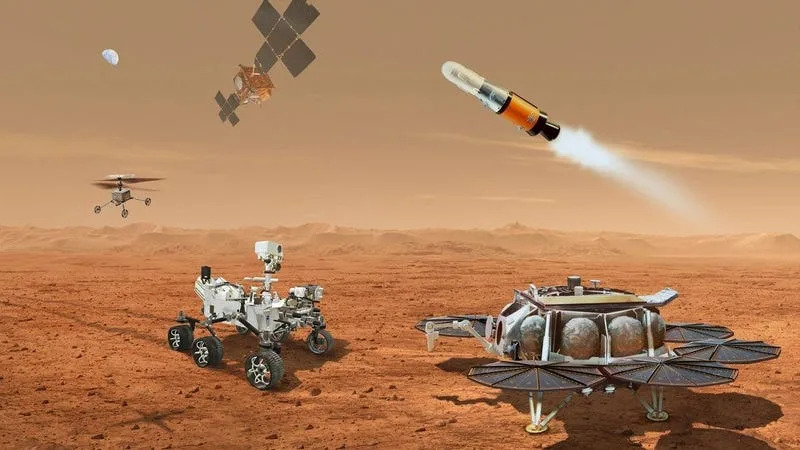Brightest flash ever disturbed Earth's atmosphere last year
Daniel Lawler
Tue, November 14, 2023

An artist's impression of the powerful blast of gamma rays, caused by an explosion in the distant universe, that reached Earth on October 9 last year (Handout)
Last year the brightest flash of light ever seen in the night sky disturbed Earth's upper atmosphere in a way that has never before detected before, researchers said on Tuesday.
A massive burst of gamma rays from an enormous cosmic explosion around two billion light years away arrived at Earth on October 9, 2022, lighting up telescopes around the world.
Quickly nicknamed the "BOAT" -- for Brightest Of All Time -- the flash lasted just seven minutes but its afterglow was visible to amateur astronomers for seven hours.
The flash activated lightning detectors in India and triggered instruments that normally study explosions on the Sun called solar flares.
It also affected long wave radio communications in the lower ionosphere, a section of Earth's upper atmosphere around 60 to 350 kilometres (37 to 217 miles) above the surface.
The BOAT also affected the upper ionosphere -- the very first time a gamma-ray burst has been observed in this section of the atmosphere, a team of Italian and Chinese researchers said on Tuesday.
From 350 to 950 kilometres above Earth, near the edge of the space, the upper ionosphere is where radiation from the Sun turns into charged particles that form an important electric field.
Mirko Piersanti, a researcher at Italy's University of L'Aquila, told AFP that experts in this field had been debating for two decades whether gamma ray bursts could have any impact on the upper ionosphere.
"I think we finally answered the question," said Piersanti, the lead author of a new study in the journal Nature Communications.
The researchers were lucky that the Chinese–Italian CSES satellite, which has an electric field detector, "was exactly in the zone that was illuminated by the gamma-ray burst" 500 kilometres above Earth in the upper ionosphere, he said.
"We found a shape in the electric field that had never been observed before," Piersanti added.
"It is amazing," European Space Agency gamma-ray expert Erik Kuulkers said in a statement.
"We can see things that are happening in deep space but are also affecting Earth."
- Extinction threat? -
Piersanti said the research would help scientists understand the potential threat that other gamma-ray bursts could pose in the future.
The worst-case scenario would be if such a powerful blast came from much closer to home -- say, within our own Milky Way galaxy. That could "completely erase" Earth's ozone layer, he said.
This would expose everything on the surface to the full might of the Sun's ultraviolet radiation, potentially wiping out life on Earth.
There has previously been speculation that past gamma-ray bursts could have caused ancient mass extinction events.
But Piersanti emphasised that much remains unknown.
It is also possible that the ionosphere would absorb all the gamma rays and "nothing would happen" to those of us on the ground, he explained.
Last year's gamma-ray burst, officially called GRB 221009A, is believed to have been caused by either a massive dying star exploding into a supernova, or the birth of a black hole.
Given its immense power, it could also have been both -- a supernova explosion leading to the creation of a black hole.
The blast came from the direction of the constellation Sagitta and travelled an estimated 1.9 billion years to reach Earth.
It is now 2.4 billion light years away because of the expansion of the universe.
On average, more than one gamma-ray-burst reaches Earth every day.
But one with the brightness of the BOAT is estimated to come around once every 10,000 years.
dl/gil
James Webb Space Telescope finds 2 of the most distant galaxies ever seen
Keith Cooper
Tue, November 14, 2023

A crowded galaxy field on a black background, with one large star dominating the image just right of center. Three areas are concentrated with larger white hazy blobs on the left, lower right, and upper right above the single star. Scattered between these areas are many smaller sources of light; some also have a hazy white glow, while many other are red or orange.
The second and fourth most distant galaxies ever seen have been spotted by the eagle eye of the James Webb Space Telescope (JWST), supporting the basic picture of galaxy formation as described by the Big Bang theory.
The discovery was made possible thanks to a huge helping hand from a massive gravitational lens in the form of the galaxy cluster known as Abell 2744, nicknamed Pandora's Cluster, which is located about 3.5 billion light-years away from us. The immense gravity of the cluster warps the very fabric of space-time sufficiently to magnify the light of more faraway galaxies.
Using the James Webb Space Telescope to search for early galaxies magnified by this cosmic lens, Bingjie Wang of the Penn State Eberly College of Science and member of the JWST UNCOVER (Ultradeep NIRSpec and NIRCam Observations before the Epoch of Reionization) team discovered two of the highest redshift galaxies ever seen.
Related: James Webb Space Telescope confirms 'Maisie's galaxy' is one of the earliest ever seen
Cosmological redshift is the stretching of light wavelengths, provoked by the continuous expansion of the universe. The more distant a galaxy is, the more the universe had expanded while that galaxy’s light traveled across space to reach us, and therefore, the more the wavelengths of that light are stretched. As wavelengths get stretched out in this manner, they go from tighter, blueish ones to redder ones, eventually falling into the invisible, infrared region of the electromagnetic spectrum. Galaxies that existed just between 300 and 400 million years after the Big Bang have had their light stretched into those infrared wavelengths that can't be seen by humans, but can indeed be detected by the JWST’s Near-Infrared Camera (NIRCam) and Near-Infrared Spectrometer (NIRSPec).
Wang and her team were able to identify the lensed images of two high-redshift galaxies. One, designated UNCOVER-z13 ("z" is shorthand for "redshift"), has a redshift of 13.079, confirming it to be the second most distant galaxy known. (The most distant confirmed galaxy is JADES-GS-z13-0, which was also discovered by the JWST in 2022 and has a redshift of 13.2.) We see UNCOVER-z13 as it existed just 330 million years after the Big Bang.
The other galaxy recently discovered, UNCOVER-z12, has a redshift of 12.393, placing it in fourth place in the all-time list of most distant galaxies. We see this realm as it was just 350 million years after the Big Bang.

composite image of pandora's cluster, with two close-up inset images
What marks the two UNCOVER galaxies out as different is their appearance. Other galaxies seen at similarly high redshifts seem to be point-like, indicating they are very small — just a few hundreds of light years across. The UNCOVER galaxies, on the other hand, have structure.
"Previously discovered galaxies at these distances … appear as a dot in our images," Wang said in a statement. "But one of ours appears elongated, almost like a peanut, and the other looks like a fluffy ball."
These galaxies are also bigger, with UNCOVER-z12 sporting an edge-on disk about 2,000 light years across, which is six times larger than other galaxies seen in this era.
"It is unclear if the difference in size is due to how the stars formed or what happened to them after they formed, but the diversity in the galaxy properties is really interesting," said Wang. "These early galaxies are expected to have formed out of similar materials, but already they are showing signs of being very different than one another."
Although the dichotomy in galaxy properties, even at this early stage in the universe, is eye-opening, both of the newfound realms have general characteristics that are strongly supportive of the Big Bang model. This model describes how, in the aftermath of our universe's creation, galaxies began life small before growing rapidly through mergers with other galaxies and gas clouds.
This growth, in turn, spurred more star formation, which ultimately increased the abundance and variety of elements contained within the young galaxies, introducing substances to them that are heavier than hydrogen and helium. The galaxies uncovered by UNCOVER — if you’ll pardon the pun — are young, small, have a low abundance of heavy elements and are actively forming stars, all of which supports "the whole paradigm of the Big Bang theory," Joel Leja, who is an assistant professor of astronomy and astrophysics at Penn State University and a co-researcher on Wang’s team, said in the statement.
Interestingly, the JWST has the ability to see even higher redshift galaxies than UNCOVER-z13 and -z12, meaning they'd be even younger — but it didn’t detect any being lensed by the Pandora Cluster. "That could mean that galaxies just didn’t form before that time and that we’re not going to find anything farther away," said Leja. "Or it could mean we didn’t get lucky enough with our small window."
Astronomers will keep looking, using a multitude of lensing clusters to open up new windows into the deep universe in search of some of the first galaxies.
The discovery was reported on Monday (Nov. 13) in Astrophysical Journal Letters.
JWST spots two of the most distant galaxies astronomers have ever seen
Laura Baisas
Tue, November 14, 2023

UNCOVER z-13 and UNCOVER z-12 are the second and fourth most distant galaxy ever observed. The James Webb Space Telescope’s Near-Infrared Camera (NIRCam) helped confirm their existence within Pandora’s Cluster (Abell 2744). They are shown here as near-infrared wavelengths of light that have been translated to visible-light colors.
A team using NASA’s James Webb Space Telescope has observed two of the most distant galaxies astronomers have ever seen. At close to 33 billion light years away from Earth, these distant regions can offer insight into how the universe’s earliest galaxies may have formed. The findings are detailed in a study published November 13 in The Astrophysical Journal Letters.
The galaxies UNCOVER z-13 and UNCOVER z-12 are the second and fourth most distant galaxies ever observed and are located in a region called Pandora’s Cluster (Abell 2744). The two galaxies are among the 60,000 sources of light in Pandora’s Cluster that were captured in some of the first deep field images the JWST took in 2022. This region of space was selected for this kind of imaging due to its location behind several galaxy clusters. The light creates a natural magnification effect called gravitational lensing. This happens when the gravitational pull of the clusters’ combined mass warps the space-time around it. It then magnifies any light that passes nearby and offers a larger view behind the clusters.
Other galaxies confirmed at this distance generally appear in images as red dots. However, these new galaxies are larger and look more like a peanut and a fluffy ball, according to the team.
“Very little is known about the early universe, and the only way to learn about that time and to test our theories of early galaxy formation and growth is with these very distant galaxies,” study co-author and astronomer Bingjie Wang from Penn State University said in a statement. “Prior to our analysis, we knew of only three galaxies confirmed at around this extreme distance. Studying these new galaxies and their properties has revealed the diversity of galaxies in the early universe and how much there is to be learned from them.”
Wang is also a member of the JWST UNCOVER (Ultradeep NIRSpec and NIRCam ObserVations before the Epoch of Reionization) team that conducted this research. UNCOVER’s early goal is to obtain highly detailed images of the region around Pandora’s Cluster using JWST.
Since the light that is emitted from these galaxies had to travel for so long to reach Earth, it offers a window into the universe's past. The team estimates that the light JWST detected was emitted by the two galaxies when the universe was about 330 million years old and that it traveled for about 13.4 billion light years to reach the space telescopes.
However, the galaxies are currently closer to 33 billion light years away from Earth because of the expansion of the universe over this period of time.
“The light from these galaxies is ancient, about three times older than the Earth,” study co-author, Penn State astronomer, and UNCOVER member Joel Leja said in a statement. “These early galaxies are like beacons, with light bursting through the very thin hydrogen gas that made up the early universe. It is only by their light that we can begin to understand the exotic physics that governed the galaxy near the cosmic dawn.”
[Related: JWST takes a jab at the mystery of the universe’s expansion rate.]
The two galaxies are also considerably bigger than the three galaxies previously located at these extreme distances. While our Milky Way galaxy is roughly 100,000 light years across, galaxies in the early universe are believed to have been very compressed. A galaxy of 2,000 light years across like one of ones the team imaged came as a surprise.
“Previously discovered galaxies at these distances are point sources—they appear as a dot in our images,” Wang said. “But one of ours appears elongated, almost like a peanut, and the other looks like a fluffy ball. It is unclear if the difference in size is due to how the stars formed or what happened to them after they formed, but the diversity in the galaxy properties is really interesting. These early galaxies are expected to have formed out of similar materials, but already they are showing signs of being very different than one another.”
To make inferences about these early galaxies, the team used detailed models. They believed that in addition to being young (by space standards), the two galaxies also had few metals in their composition, and were growing rapidly and actively forming stars.
“The first elements were forged in the cores of early stars through the process of fusion,” Leja said. “It makes sense that these early galaxies don’t have heavy elements like metals because they were some of the first factories to build those heavy elements. And, of course, they would have to be young and star-forming to be the first galaxies, but confirming these properties is an important basic test of our models and helps confirm the whole paradigm of the Big Bang theory.”
Astronomers will continue to use lensing clusters and the instruments aboard the JWST to continue to peel back the timeline of some of the universe’s first galaxies.
NASA 'Pauses' Mars Sample Return to Get a Grip on the Mission
Passant Rabie
Tue, November 14, 2023

An illustration of the spacecraft fleet designed to retrieve samples from Mars.
NASA is pulling back from its Mars Sample Return program (MSR) in order to develop a revised way of bringing the Martian rocks back to Earth after its original plan was deemed unrealistic.
During a meeting of the Planetary Science Advisory Committee on Monday, NASA officials announced that the space agency is pausing work on MSR in response to a recent report that called out the mission’s mounting costs and delays, Space Policy Online reported. Last week, three NASA centers involved in the MSR program were directed to begin “ramping back” on activities related to the mission, according to Sandra Connelly, deputy associate administrator for science at NASA.
“We’re pausing the program in fiscal year 2024 while we go off and consider how best to understand and then incorporate how we’re going to change the program and respond to the IRB’s findings,” Jeff Gramling, MSR program director at NASA, is quoted in Space Policy Online as saying during the meeting on Monday. “It’s not just about the architecture, it’s about how do we position the program for long term success and that may mean looking at organizational complexity, internal communications, and how we’re structured to achieve this mission.”
The Sample Return mission involves a group of robots, landers, and orbiters working on and off Mars. NASA’s Perseverance rover is currently collecting rocky samples before stowing them away for a Sample Retrieval Lander to load them up onto a small rocket, from which they will be launched towards another spacecraft in orbit around Mars that is designed to drop them off at Earth in the mid 2030s.
One of the alternative options outlined in the report suggest launching the lander and the orbiter on separate dates, while another suggestion would hand off the responsibility of the orbit entirely to the European Space Agency (NASA’s partner on the mission). During a meeting in late October, Gramling also suggested reducing the quantity of samples returned from Mars, which would result in a smaller container built to house the samples and, therefore, a smaller spacecraft assigned to bring them back to Earth. A smaller spacecraft could reduce cost and complexity for the overall architecture, according to Gramling.
Despite its complex nature, NASA will likely not give up on its Martian sample retrieval mission as it makes up a great portion of the space agency’s plans to send its astronauts to the Red Planet in the 2030s. It also holds significant value in terms of providing important information regarding whether Mars could have hosted some form of life during its ancient past, answering the ultimate question of whether life exists beyond Earth.
It just might take us a little while longer to have those answers as the mission seemingly still has a long way to go before it can drop off the other worldly samples on our planet.
Pentagon Awards Lockheed Martin $33.7 Million for Nuclear Spacecraft Project
Passant Rabie
Mon, November 13, 2023

An artistic rendering of a space nuclear reactor system designed to produce high-power electricity.
An artistic rendering of a space nuclear reactor system designed to produce high-power electricity.
Lockheed Martin is at the early stages of developing a nuclear propulsion system to power a spacecraft through the depths of the cosmos.
Under a $33.7 million contract from the Air Force Research Laboratory (AFRL), Lockheed Martin announced that it was in the “preliminary design review stage” of the Joint Emergent Technology Supplying On-Orbit Nuclear (JETSON) program. The Air Force is asking the company to “mature high-power nuclear electric power and propulsion technologies and spacecraft design,” according to a Lockheed statement.
The Maryland based company is one of three companies awarded contracts by the Air Force in late September to develop nuclear powered vehicles for spaceflight, the two others being Intuitive Machines and Westinghouse Government Services. Lockheed Martin received the largest portion of the funding by far, with $16.9 million going towards Westinghouse and $9.4 million awarded to Intuitive Machines. All three contracts extend through December 2025.
Lockheed Martin is also developing a nuclear-powered rocket intended for long-distance space travel as part of a collaboration between NASA and the Defense Advanced Research Projects Agency (DARPA), which was announced in July. The rocket is scheduled for a test flight in 2027, and is an integral part of NASA’s plans to send a crewed mission to Mars. Meanwhile, the JETSON nuclear-powered propulsion system could go into critical design review level, the company stated.
Gizmodo
No comments:
Post a Comment